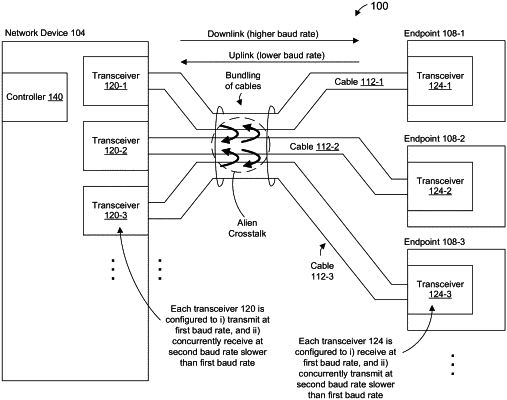| CPC H04B 3/32 (2013.01) [H04B 3/21 (2013.01)] | 30 Claims |

|
1. A first network device for communicating via a first cable and a second cable that is separate from the first cable, comprising:
a first transmitter configured to transmit a first Ethernet signal via the first cable at a first baud rate that corresponds to a first minimum required bandwidth, the first minimum required bandwidth exceeding a maximum bandwidth rating of the first cable;
a second transmitter configured to transmit a second Ethernet signal via the second cable at a second baud rate concurrently with transmission of the first Ethernet signal via the first cable;
a first receiver configured to receive a third Ethernet signal via the first cable concurrently with transmission of the first signal via the first cable and transmission of the second signal via the second cable, the third Ethernet signal having been transmitted by a second network device at a third baud rate that is lower than both i) the first baud rate and ii) the second baud rate, wherein the third baud rate is selected to locate the third Ethernet signal in a frequency range in which a maximum power level of first crosstalk in the first cable is lower than power levels of the first crosstalk at frequencies above the frequency range, the first crosstalk in the first cable caused by the transmission of the second Ethernet signal in the second cable, wherein the third baud rate corresponds to a second minimum required bandwidth that is no more than the maximum bandwidth rating of the first cable, wherein the second baud rate corresponds to a third minimum required bandwidth that exceeds a maximum bandwidth rating of the second cable, and wherein reception of the third Ethernet signal at the third baud rate that is i) lower than the second baud rate, and ii) is no more than the maximum bandwidth rating of the first cable, facilitates mitigation of the first crosstalk in the third Ethernet signal caused by transmission of the second Ethernet signal in the second cable at the second baud rate;
wherein the first receiver includes circuitry configured to process the third Ethernet signal to mitigate second crosstalk in the third Ethernet signal caused by the transmission of the first Ethernet signal in the first cable.
|